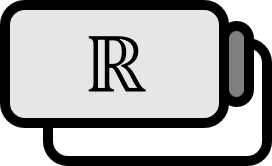The Fundamental Theorem of Calculus in Analysis
Theorem1
Let’s say $f$ is a function that is Riemann integrable over the interval $[a,b]$. And let’s define $F$ for $a\le x \le b$ as follows.
$$ F(x) = \int _{a} ^{x} f(t)dt $$
- (a) Then, $F$ is continuous over $[a,b]$.
- (b) If $f$ is continuous over $x_{0}\in [a,b]$, then $F$ is differentiable over $x_{0}$ and satisfies $F^{\prime}(x_{0})=f(x_{0})$.
Explanation
This is known by the name Fundamental Theorem of Calculus 1, often abbreviated as FTC1. It means that if $F$, defined as the definite integral of $f$, is differentiable, then it has $f$ as its derivative.
Proof
(a)
Since we assume that $f$ is integrable, it is bounded. Thus, $M=\sup \limits_{[a,b]}\left| f \right| <\infty$. If $M=0$, then it is trivial that $f=F=0$. Therefore, let’s say $M>0$. And let’s say $a\le x< y \le b$. Since integrability is preserved within the interval, the following holds.
$$ \begin{equation} \begin{aligned} \left| F(y)-F(x) \right| &= \left| {\color{blue}\int_{a}^{y}f(t)dt}-\int_{a}^{x}f(t)dt \right| \\ &= \left| {\color{blue} \int_{a}^{x}f(t)dt+\int_{x}^{y}f(t)dt}-\int_{a}^{x}f(t)dt \right| \\ &= \left| \int_{x}^{y}f(t)dt \right| \end{aligned} \label{eq1} \end{equation} $$
Also, since the absolute value of the integral is less than the integral of the absolute value, the following holds.
$$ \begin{equation} \begin{aligned} \left| F(y)-F(x) \right| &= \left| \int_{x}^{y}f(t)dt \right| \\ & \le \int_{x}^{y}\left| f(t) \right|dt \\ &\le \int_{x}^{y}Mdt \\ &= M(y-x) \end{aligned} \label{eq2} \end{equation} $$
Summarizing these, we get the following.
$$ \left| F(x)-F(y) \right| \le M(y-x) $$
Now, let’s assume an arbitrary positive number $\varepsilon >0$ is given. And say $\delta = \dfrac{\varepsilon}{M}$. Then, we can observe the following holds.
$$ \left|y-x \right| <\delta \quad \implies \quad \left|F(y)-F(x) \right|<\varepsilon,\quad \forall x,y \in [a,b] $$
Therefore, by the definition of a continuous function, $F$ is continuous2.
■
(b)
Let’s say an arbitrary positive number $\varepsilon >0$ is given. Assuming that $f$ is continuous over $x_{0}$, by the definition the following $\delta >0$ exists.
$$ \begin{equation} \left|x-x_{0} \right| <\delta \quad \implies \quad \left|f(x)-f(x_{0}) \right|<\varepsilon,\quad x\in[a,b] \label{eq3} \end{equation} $$
Then, proving the following by the definition of derivative concludes the proof.
$$ F^{\prime}(x_{0}) := \lim \limits_{x\to x_{0}}\frac{F(x)-F(x_{0})}{x-x_{0}} = f(x_{0}) $$
Let’s say $t \in [a,b]$ satisfies $x_{0} < t <x_{0}+\delta$. (The process is the same even for the case of $x_{0}-\delta < t < x_{0}$, only the sign changes a little.) Then, the following holds.
$$ \begin{align*} \left| \frac{F(t)-F(x_{0})}{t-x_{0}}-f(x_{0}) \right| &=\left| \frac{1}{t-x_{0}}\left( \int_{a}^{t}f(x)dx-\int_{a}^{x_{0}}f(x)dx \right) -f(x_{0}) \right| \\ &=\left|\frac{1}{t-x_{0}} \int_{x_{0}}^{t}f(x)dx -f(x_{0}) \right| \\ &=\left| \frac{1}{t-x_{0}} \int_{x_{0}}^{t}f(x)dx -\frac{1}{t-x_{0}}\int_{x_{0}}^{t}f(x_{0})dx \right| \\ &=\left| \frac{1}{t-x_{0}} \int_{x_{0}}^{t}\left( f(x)-f(x_{0}) \right)dx \right| \\ &< \left| \frac{1}{t-x_{0}} \int_{x_{0}}^{t}\varepsilon dx \right| \\ &< \left| \frac{1}{t-x_{0}}\varepsilon (t-x_{0}) \right| \\ &= \varepsilon \end{align*} $$
The second equality holds for the same reason that $\eqref{eq1}$ holds. The third equality holds for the same reason that $\eqref{eq2}$ holds. The fourth equality holds because integration is linear. The first inequality holds due to $\eqref{eq3}$. Since $\varepsilon$ is an arbitrary positive number, we obtain the following.
$$ \frac{F(t)-F(x_{0})}{t-x_{0}}=f(x_{0}) $$
Therefore, the following holds.
$$ F^{\prime}(x_{0})=\lim \limits_{t\to x_{0}}\frac{F(t)-F(x_{0})}{t-x_{0}}=\lim \limits_{t\to x_{0}}f(x_{0})=f(x_{0}) $$
Thus, $F$ is differentiable over $x_{0}$, and the derivative value over $x_{0}$ is as $f(x_{0})$.
■
